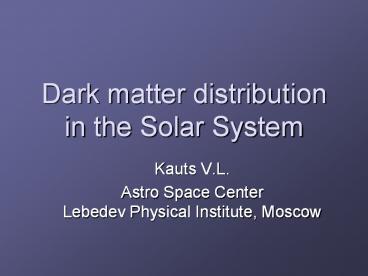Dark matter distribution in the Solar System - PowerPoint PPT Presentation
Title:
Dark matter distribution in the Solar System
Description:
baryon compression. Observational capabilities ... Baryons. Dark matter potential. Baryon compression. L ... Baryon compression. Spherical compression profile ... – PowerPoint PPT presentation
Number of Views:21
Avg rating:3.0/5.0
Title: Dark matter distribution in the Solar System
1
Dark matter distribution in the Solar System
- Kauts V.L.
- Astro Space Center Lebedev Physical Institute,
Moscow
2
- Galactic dark matter distribution in Solar System
vicinity - Dark matter density enhancement mechanism
- gravitation-collisional capture
- gravitational capture
- particle focusing in Solar System gravitational
field - baryon compression
- Observational capabilities
3
Galactic dark matter distribution in Solar System
vicinity
Dark matter potential
Baryons
4
Baryon compression
- L constant
- Before
- After
gt
5
Solar System vicinity
6
Gravitation - collisional capture
V8D.M. 300 km/s
Vsunpar. 600 km/s
VsunD.M. 660 km/s
Sun
Bound orbit gt 10 velocity loss
7
Particle deceleration in Sun Electric charge e
p Fe 1 36 0.02 Magnetic charge e
p Fe 1 0.02 210-7
Energy lose
Electric Magnetic
8
Major semiaxis
Electric Magnetic
9
Gravitation - collisional capture
few solar radius (1 a.u. 200 solar radius)
Halo
Fine tuning (Dark Matter particle mass,
cross-sections)
10
Gravitational capture
Capture condition
Orbital Jupiter velocity 13 km/s
Jupiter
Sun
Cross-section s pR2
gt R 2RO
!!! inverse scattering, no cosmological storage
11
Gravitation - collisional capture
Gravitational capture
(DamourKrauss)
Sun
Jupiter
- Graze the Sun
- Subsequent orbit evolution
- U(r) r2 1/r
- Perturbation of planets gravitational field
12
Particle focusing in Solar System gravitational
field
n8
n(r)
(isotropic case)
(anisotropic case)
if
13
V8D.M. 300 km/s
Vsunpar. 600 km/s
Sun
Sun
14
1.
ltlt1
gtgt1
15
2.
16
Particle focusing in Solar System gravitational
field
Sun surface
1. White dwarf
gt
2. Neutron star
gt
gt
3. Sun
17
Caustic
n8
n(r)
?
Sun
z
18
Sun
600
Earth
Temperature and velocity of interstellar medium
were measured (Kurt V.G. et al) Line HeI (?
584?)
19
No focusing effect by planet
- Orbital
Vorbital_Earth 30 km/s
Vorbital_Jupiter 13 km/s
- Halo around planet
Vpar_Earth 11.2 km/s
Vpar_Jupiter 61 km/s
20
Baryon compression
- Spherical compression profile
21
Observational capabilities (gravitational testing
of Dark Matter)
n 10 n8
aD.M.10-19 cm/s2 a(RadioAstron) 10-6 cm/s2
Moon
Earth
aD.M.310-15 cm/s2 a(Pioneer) 810-8 cm/s2
70 a.u.
Sun
R
Celestial mechanics in Solar System ?D.M. lt
10-19 - 10-20 g/cm3
22
Conclusion
There are some proved dark matter density
enhancement mechanisms in Solar System. The
coefficient of amplification is in the order of
few units. It is very important for the
modulating dark matter detector signals (noon
night, summer winter effects), but direct
detection of dark matter in Solar System by its
gravitational effects is quite difficult.































